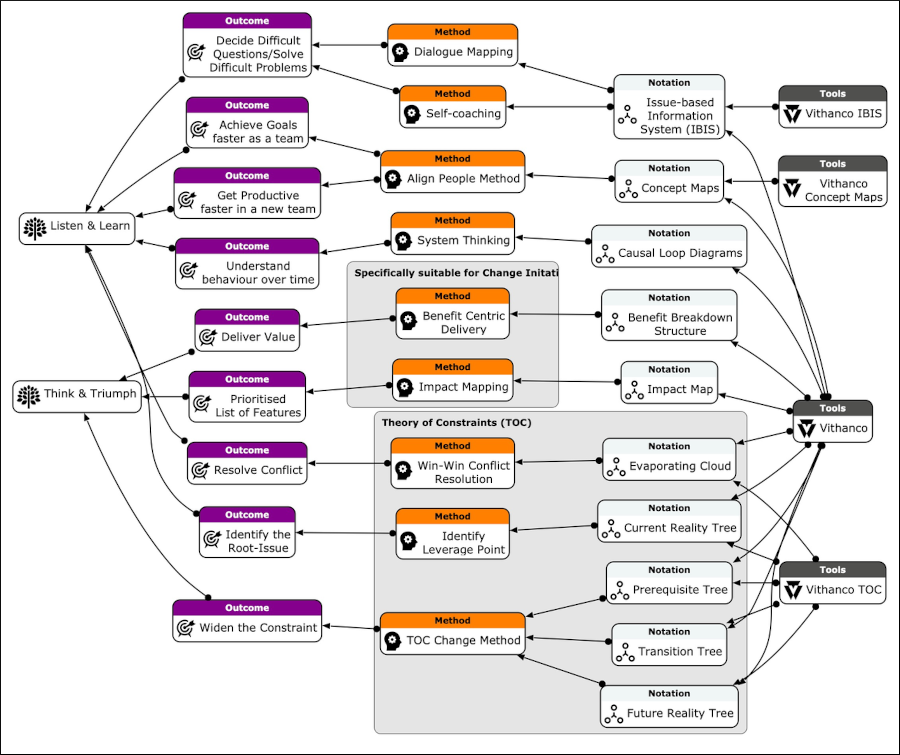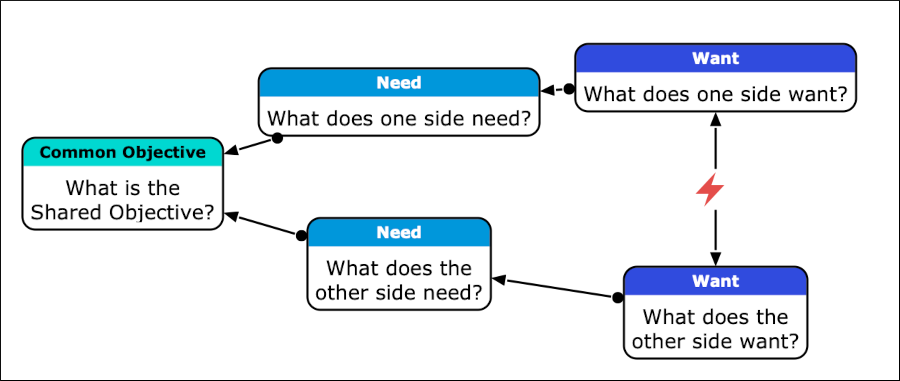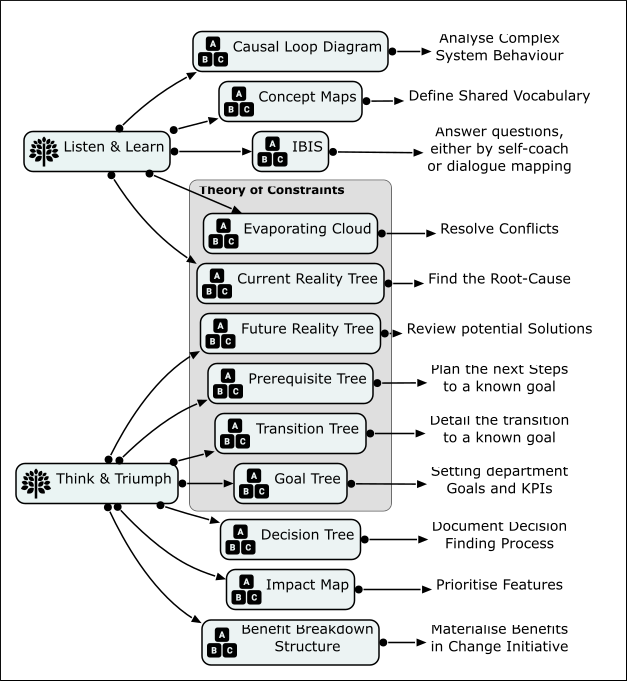
There are many visual thinking methods available to us. But too often, we don’t use them because we don’t know the full range of techniques we can use to think through and express our ideas visually. So when I find someone who has classified and is teaching others what’s possible, it always gets my attention. And I love to share it with you, so you can benefit from it, too.
I recently had an opportunity to chat with Klaus Kneupner, an entrepreneur who has developed Vithanco, a set of structured visual thinking tools and methods and a Mac application that helps you put its principles and techniques to work to analyze and communicate your ideas clearly and concisely.
Here’s what you need to know about Vithanco, captured in my interview with Klaus:
Chuck Frey: What is your background and experience in the world of visual thinking?
Klaus Kneupner: My problem was always that I liked visuals, but I couldn’t draw nicely. And if I did a diagram, for example in Visio, I quickly fell into a 1-minute content change and 5-minute layout change loop. Even my PowerPoint slides never looked as good as other people’s slides. It was frustrating.
But then I met a guy who used mind maps to overcome his dyslexia. It looked simple enough to me. Curious as I am, I started to use it as well. At that time, MindNode on the Mac was released and had themes, so my mind maps looked good without me doing anything. I used MindNode for everything:
- Analyzing problems
- Capturing meetings
- Planning projects
- Create reading notes from books
- Some of the book notes went on to my website, kneupner.de
Someone suggested a tool called Flying Logic to create cause-effect diagrams. The tool uses a network graph as data structure and not a tree, as mind maps do. In addition, every node had a type, like “positive effect” or “negative effect.” It was a revelation. Suddenly, the expressiveness of the diagrams increased dramatically.
I read about the original use case of Flying Logic: Theory of Constraints. So, the diagrams had a theoretical foundation that a mind map needed to have. The lines between the nodes had a meaning, and if done correctly, the diagrams also had a grammar. Some nodes should be connected to particular other nodes. What looks like a restriction is a great help. It helps to focus on the essential things and to ask the right questions.
What made me look for further notations, I cannot remember. But I found all these other notations that could help in various ways to think about problems. IBIS notations help to drill deeply into problems or to map dialogues. Benefit Breakdown Structures allow one to plan a project; Concept Maps align on terminology. All of these present information in an easy-to-understand graphical/visual way, looking better than my PowerPoint slides and more expressive than my mind maps. Many of them even have a theoretical foundation.
Frey: What made you decide to create Vithanco, and how would you summarize its mission?
Kneupner: So, I had found notations. Instead of the metaphorical hammer that turned all problems into nails (in other words, mind maps), there was a whole toolbox out there, but each notation was somehow locked into a different tool. These tools were of very different quality, with a different user interface. I needed one tool to provide all the notations. A tool that helps to maintain the grammar of the note and, of course, a device that creates good-looking diagrams without me having to do anything.
Many people, if not all, can benefit from these different notations. Vithanco should be the tool that makes it easy for all to use the other notes.

Frey: What needs does Vithanco fill?
Kneupner: I thought a lot about this question. The theory of constraints has a simple focus question: What is the limitation that a tool/app helps to overcome? And the limitation that Vithanco overcomes is complexity. With Vithanco, you can digest more information than you would do otherwise:
- A visual diagram helps you to “see” the problem.
- Lines between nodes show the intrinsic relations between concepts and show visually where to start and where to focus.
- Auto-layout reduces the complexity of modelling the content.
- Methods/notations take some complexity out of the thinking process.
- The resulting diagram minimizes the complexity of communicating the solution and makes it easier to document your thought process for future reference.
Frey: What are some of the biggest challenges business people face today that visual thinking can help them solve?
Kneupner: There are at least two layers to this question.
Visual thinking as a technique helps to reduce complexity. It simplifies communication over the diagram, making it easier to document the thinking process. The significant requirement is, of course, that one takes time to think something through. In our fast-paced life, it happens less and less often that people take the time to think something through. I have met managers who pride themselves on making decisions quickly. I see the value of fast decisions, especially when the consequences of either way are marginal. But often, you have tricky problems and must invest energy in understanding the issue.
Structured Visual Thinking Methods guide you on how to think about a problem. For example, suppose you separate a change initiative into strategic objectives, benefits, business changes and enablers. In that case, you can ask the right questions and set up the initiative correctly, increasing the chances of success. Another method (Align Stakeholders) ensures that people use the same terminology. I have seen people using the exact words but had very different understandings. These people will lose time and effort as their work won’t be compatible, and frustration and rework are inevitable. As a final example, the Theory of Constraint Thinking Processes helps you to identify and widen the bottleneck that makes your life difficult. These methods all focus on concrete outcomes: a change plan, stakeholder alignment and improved throughput. And there are more of these methods out there. Look at my website, vithanco.com, for more.
Frey: Based on what I saw on your website, a big need of people today seems to be clarity. Why is that so hard to achieve?
Kneupner: Clarity requires that you understand something fully. Using the correct method improves the probability of obtaining the proper outcomes. The structured visual representation facilitates discussion with others, helping you to find the loopholes.
Frey: How would you characterize the average person’s approach to thinking today?
Kneupner: Most people seem not to spend much time thinking. We are constantly busy and consume readily available series, games, social media or similar in our spare time. At the same time, I got the impression that workplaces require faster responses and deliveries, leading to less thinking and more repetition of previous thought processes. For example, I spoke with management consultants that use a few screening questions and then, based on the input, adjust slide deck #3 to “help” their clients. Only a little reflection is required. There might have been some consideration for creating the initial slide decks, but now it’s a repetition.
Who is thinking things through nowadays? I know many people do. But most don’t. It might be a sign of our times that people rush through life without thinking along new paths. People might consume more. I often think of the “bored but brilliant” slogan that became a book.
Frey: What is structured visual thinking and how does it help address the shortcomings that affect most people’s thinking?
Visual thinking includes the visual sense in thinking.
Structured Visual Thinking doesn’t require any artistic ability. Instead, you have a visual language with some grammar, providing the structure for the thoughts. You draw relationships between ideas/thoughts and depict meaning.
Structured Visual Thinking methods guide you toward meaningful diagrams that allow you to achieve outcomes.
Sometimes, the thought process to create the diagram with clarity of mind is the outcome. Sometimes, the diagram is just the blueprint for the next steps.
Frey: In a previous conversation, you observed that structured visual thinking enables its users to ask the right questions. Why are questions so important and what characterizes the right types of questions?
Kneupner: Questions were always a tool to teach, at least since Plato made Socrates’ approach famous. In his dialogues, Socrates primarily covers much to think about simply by asking questions. In modern society, you have the role of a coach. A coach is specifically not someone who provides answers (that would be a mentor) but someone who asks questions. Questions that trigger the thinking process. Questions that allow the coaches to discover the next steps. You learn more if you are formulating the answers instead of getting the answers – simply because it requires “putting things together.” I have learned that myself. The solution stayed with me when pondering a question and solving the problem. An answer that I only read is usually forgotten quickly.
I am excited when I realize that a method guides me to ask the right questions. For example, I am a big fan of the Evaporating Cloud, a tool from the Theory of Constraints body of knowledge. It is based on defining a problem as a statement of two opposing/conflicting ideas. So, to construct the evaporating cloud, you need to answer the question after these two conflicting ideas. It even goes further by guiding questions after the wants and needs.

Once you have this cloud, you “solve” it by asking for the assumptions. If there is a shared goal, there must be at least one wrong assumption on one side. Therefore, you ask for the assumptions, and you ask for each assumption whether it is valid. Once you find the underlying wrong belief, the conflict will evaporate.
This process represents a simple process, guided by questions to lead in a constructive manner to conflict resolution. I love it. I have a longer description of this method here.
Frey: If someone adopts structured visual thinking, what kind of results can they expect?
Kneupner: This question has again at least two layers.
First, the direct results depend on what method you follow and which notation you use. A selection of outcomes based on the notations is here:

Second, the indirect results come from having more ways of thinking about your problems. When I created only mind maps, I had a limited toolbox. Structured Visual Thinking brings more tools and, as such, allows me to pick the right tool for the right task.
Frey: How does mind mapping tie in with structured visual thinking?
Kneupner: A mind map is also a structured visual thinking tool. A mind map is a tree structure, and a child node is usually a detail of the parent node. Sometimes, the parent node is a question, and the children are the answers. However, this relationship is unclear to the tool, so that little support can be provided. We only know that there is this hierarchy of nodes.
The tree structure is often not enough. Most mind-map tools allow the creation of a link between two nodes. For me, it only shows that the mental model for the mind map is too simplistic and used in too many ways that the structure doesn’t always fit.
Sometimes, like when you want to describe a mind map of a book, the structure is excellent. You can detail what information is in which section. Vithanco supports, of course, mind maps. If you want to visualise something different, use a distinct visual language; hence, use another notation.
Frey: Is structured visual thinking strictly an individual set of visual thinking methods or can small teams use it to collaborate more effectively and get more done?
Kneupner: Jeffrey Conklin wrote this great book about Dialogue Mapping. He describes in great detail how a facilitator can moderate big groups of people to create a shared understanding, by reflecting a whole discussion into a single IBIS diagram. I have seen a resulting diagram with over 1,000 nodes, where people sat together over weeks to align on a difficult (“wicked”) problem with the help of structured visual thinking. Or think of the previously mentioned Align Stakeholder Method. Here, the facilitator brings a group together to align on the language used to discuss the problems. And did you ever try to define a project on your own? Me, neither.
I know that simple visuals connect people. They can transfer ideas quicker and communicate faster, allowing you to get feedback faster. A shared diagram in a group session will ensure everyone has similar mental models. A project set up by a group with a shared pool of meaning will nearly always be better planned than if only one person designed it.
Again, methods with the right guiding questions help a group to align on what is essential much faster. I believe that collaboration is critical and that groups can benefit even more than individuals. I have some ideas about how to make it even more relevant to groups but that will have to be told another time.
Frey: Where can the readers of this blog learn more about structured visual thinking?
Kneupner: I have the vithanco.com website, where I add more and more information as my time allows. I also write a newsletter. You can sign up at newsletter.vithanco.com.
I suggest the original literature for each of the methods but hope that my descriptions and the notation support through Vithanco are helpful to get started. However, I welcome all kinds of feedback. If you tell me where you need help with a method, notation or tools, I take it as an opportunity to improve my previous work.
Asking questions helps me. So, please, bring them forward!

Leave a Reply